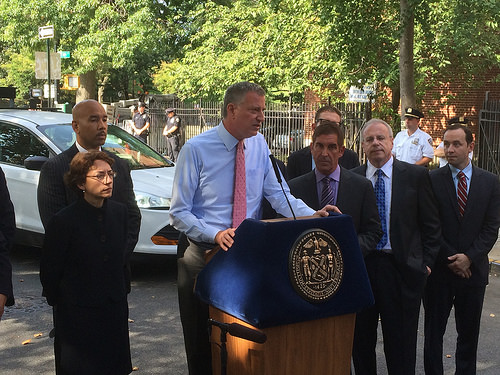10 months in: New York’s Vision Zero in comparison
Numbers released by the NYPD last week count 202 traffic fatalities in New York City between January and October 17, a decrease of roughly 10% from a similar period in 2013 (January through the end of October). Predictably, the press and public—products of the city’s hurry-up, get-‘er-done-yesterday culture—are expressing impatience with Vision Zero, Mayor de Blasio’s plan to reduce traffic deaths to zero by 2024.

Mayor Bill de Blasio discusses Vision Zero at PS95 in New York City. From Ruben Diaz Jr.
“A lot more needs to be done,” Caroline Samponaro of Transportation Alternatives, a transportation advocacy nonprofit, told the New York Post.
The criticism may stem in part from the initiative’s almost 20-year history, which dates to 1997, when public health researchers in Sweden stopped accepting the idea that human deaths or lifelong suffering from traffic accidents were inevitable. Dubbing their effort “Vision Zero,” lawmakers there began implementing policies and practices that aimed to reduce road traffic fatalities and serious injuries to zero, with safety valued over speed and convenience when new roads were being designed.
Sweden’s 2+1 roads are one example of how Vision Zero changed their landscape. During the 1990s, the country’s 43-foot-wide, two-lane rural roads were its most dangerous, accounting for 25% of severe injury collisions, despite tallying less than 4% of Sweden’s total road network. The roads were redesigned to feature three narrow lanes divided by a cable barrier at the centerline. The central lane takes turns between traffic directions at regular intervals, affording vehicles multiple passing opportunities. 900 miles of Sweden’s roads converted to the 2+1 design in the first decade of Vision Zero, saving an estimated 145 lives.
Though the country has yet to reach the magical goose egg of zero, its Vision Zero efforts have yielded impressive results. Just three of every 100,000 Swedes die on the road annually, compared to 11.4 per 100,000 in the United States, though the number of cars in circulation and the number of miles driven in Sweden have both doubled since 1970. The number of road deaths during that same period also dropped by four-fifths.
Such numbers have proven convincing to American regulators, with policymakers in Minnesota, Utah, and Washington state adopting similar approaches. Since doing so, each has seen a decrease in traffic fatalities of 43%, 48%, and 40%, respectively. New York and San Francisco, which announced its Vision Zero goals earlier this year, are hoping for similar or better reductions. Other cities are also hopping on the Vision Zero bandwagon, with supporters in New Orleans and Arlington, VA, urging politicians to incorporate elements of the initiative into local bylaws.
New Yorkers, in the meantime, can look forward to slow change, literally and figuratively: in November, the city will reduce the speed limit from 30 mph to 25 mph, a move that Vision Zero advocates claim can halve traffic fatalities.
Supporters of Vision Zero were given further cause to celebrate last month, when the U.S. Department of Transportation awarded New York a $25 million grant. The funds will be directed to 13 separate Vision Zero projects that aim to improve pedestrian and bike access in areas such as Gowanus in Brooklyn and P.S. 54 and 239, both in Queens.
Related Posts
Category: Legislation

















